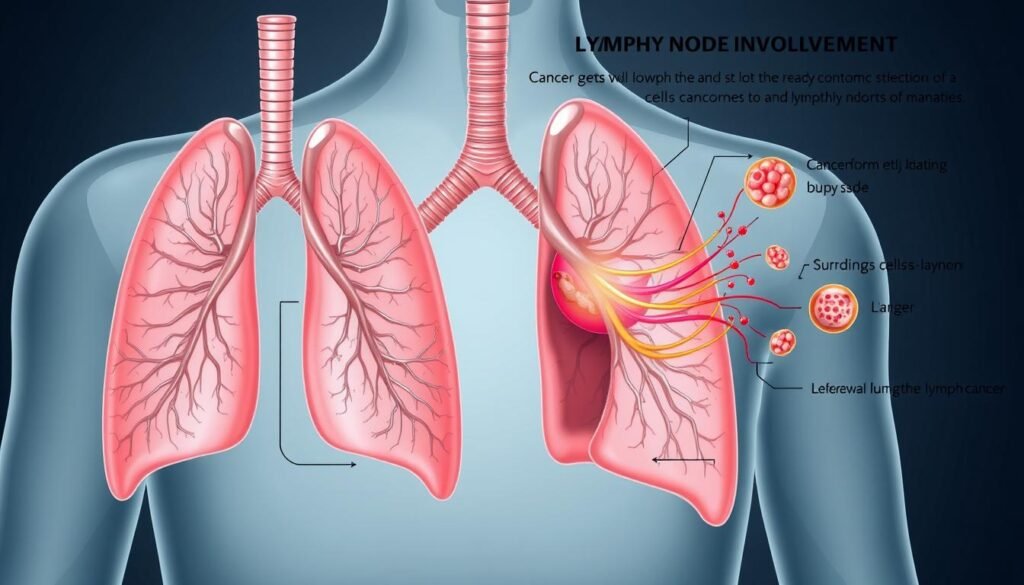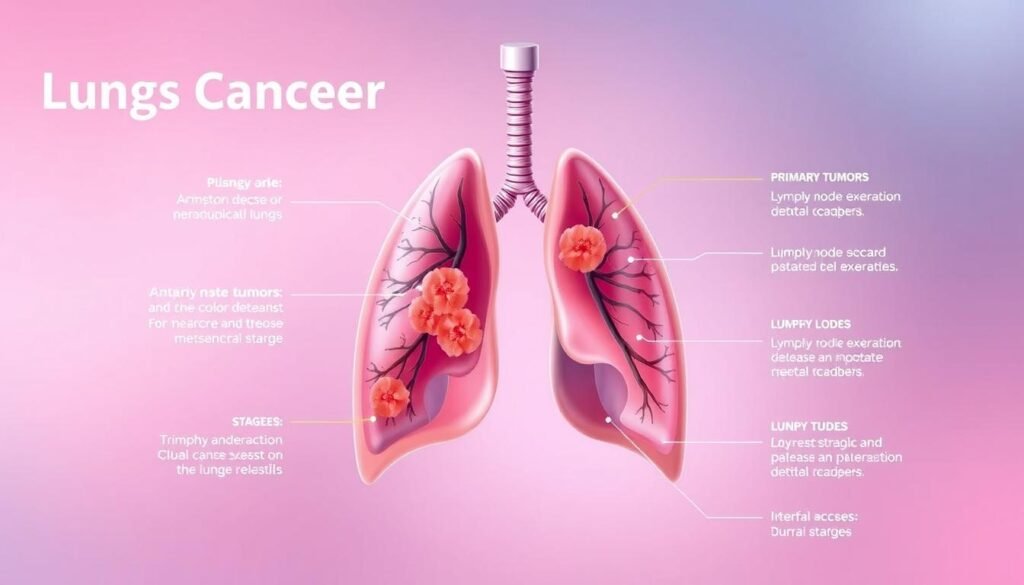Did you know the survival rate for lung cancer patients over five years is only 17%? This low number shows how serious lung cancer is. It gets even more critical when the cancer spreads to the lymph nodes. When cancer spreads like this, it’s called metastasis. This makes the cancer harder to treat. Knowing how lung cancer spreads to the lymph nodes is key. It shows the cancer is in a more advanced stage. This knowledge helps in planning how to diagnose, stage, and treat the cancer. Most patients, up to 75%, have symptoms because their disease has advanced or spread. Understanding metastasis helps patients and their families deal with lung cancer better.
Key Takeaways
- Lung cancer often metastasizes to lymph nodes, indicating advanced disease.
- The survival rate for lung cancer patients remains low at only 17%.
- Up to 75% of lung cancer cases present with symptoms related to metastasis.
- Diagnostic imaging plays a critical role in detecting lymph node involvement.
- Understanding lymphatic spread is essential for effective treatment planning.
- Support resources are available to assist patients and families coping with lung cancer.
Understanding Lung Cancer Metastasis
Knowing how lung cancer works is key to treating it right. When lung cancer spreads far from where it started, we call it metastatic. This means the cancer now affects more than just the lungs.
This stage has big effects on how doctors manage and treat the condition.
Definition of Metastatic Lung Cancer
Metastatic lung cancer moves from the lungs to other parts of the body. It can reach the lymph nodes, liver, brain, bones, and adrenal glands. It’s important to catch this spread early.
Most people find out they have lung cancer after it has already spread. At stage 4, the chance of surviving five years is only 8 percent if it reaches far parts of the body.
Primary vs. Secondary Cancer
We need to know the difference between where cancer starts and where it ends up. Primary cancer begins in one place like the lungs. Secondary cancer spreads from the primary site to new areas.
If you find swollen lymph nodes, it might mean the cancer has moved. But, other things can cause swelling too. Each lung cancer type spreads in its own way, affecting treatment choices. For more about how lymph nodes affect lung cancer, check this source.
How Lung Cancer Spreads to Lymph Nodes
Lung cancer spreads through complex processes. It’s important to know how this happens, especially when lymph nodes are involved. The lymphatic system helps spread cancer to lymph nodes. These nodes filter lymph fluid and may contain cancer cells from the main tumor.
Role of the Lymphatic System
The lymphatic system helps with immune response and fluid balance. In lung cancer, malignant cells can move to lymph nodes. Studies show that the lymphatic system may change immune cell behavior in these nodes. Cancer cells in nodes might use proteins to hide from the immune system.
Common Pathways of Spread
There are main ways cancer spreads, affecting treatment and outlook. The three main pathways are:
- Lymphatic Spread: Cancer cells move to nearby lymph nodes through the lymphatic system, raising the risk of more spread.
- Circulatory System: Cancer cells travel to other organs through blood, making treatment harder and marking new cancer sites.
- Bronchial Tree: Tumor cells spread within the lungs, affecting health and future.
Tumor surroundings also affect cancer spread. For instance, certain immune cells might help the tumor grow or fight it off. Knowing this helps us understand lung cancer spread better and find new treatments.
| Pathway | Description | Implications for Treatment |
|---|---|---|
| Lymphatic Spread | Migration through lymphatic vessels to regional nodes. | Potential for localized therapies targeting lymph nodes. |
| Circulatory System | Transport through blood vessels to distant tissues. | Requires systemic therapies or clinical trials for advanced treatment. |
| Bronchial Tree | Local spread within the lung’s internal structure. | Surgical options may be prioritized for localized cancer. |
Lung Cancer Metastasis to Lymph Nodes
Lymph nodes play a key role in lung cancer. They filter cancer cells from the primary tumor. This helps doctors decide on the best treatment.
Importance of Lymph Node Involvement
Lymph node involvement shows how far lung cancer has progressed. It indicates the disease’s advancement but does not label it as metastatic alone. The size and spread of the tumor are also considered. For example, a stage IIB tumor with lymph nodes involved suggests a more serious condition needing strong action.
Staging Implications
The TNM system uses lymph node status to plan treatment. Here’s how stages and lymph node involvement match up:
| Stage | Tumor Size | Lymph Node Involvement | Metastasis |
|---|---|---|---|
| Occult | TX | N0 | M0 |
| In-situ | Tis | N0 | M0 |
| IA1 | T1mi (≤1 cm) | N0 | M0 |
| IA2 | T1b (>1 cm to ≤2 cm) | N0 | M0 |
| IA3 | T1c (>2 cm to ≤3 cm) | N0 | M0 |
| IB | T2a (>3 cm to ≤4 cm) | N0 | M0 |
| IIA | T2b (>4 cm to ≤5 cm) | N0 | M0 |
| IIB | T1a/T1b/T1c (≤3 cm) | N1 | M0 |
| IIB | T2a/T2b (>3 cm to ≤5 cm) | N1 | M0 |
| IIIA | T1a/T1b/T1c (≤3 cm) | N2 | M0 |
Knowing the lymph node status helps doctors understand cancer’s stage. They can then choose the right metastatic cancer treatment. This way, treatment works better, possibly improving survival rates.
Types of Lung Cancer and Lymph Node Involvement
It’s important to know about the different types of lung cancer. This helps doctors create the best treatment plans. There are two main types: Non-small cell lung cancer (NSCLC) and small cell lung cancer (SCLC). Each type affects lymph nodes in its own way. How they spread changes how a patient is treated and their outlook.
Non-Small Cell Lung Cancer (NSCLC)
Most lung cancer patients have non-small cell lung cancer. It grows slower than small cell lung cancer. NSCLC has a few subtypes, with adenocarcinoma being very common. Adenocarcinoma is often found in people who never smoked. It can spread to lymph nodes as it gets worse.
The stages of NSCLC run from 0 to IV. Stage 0 means cancer is only in the lung lining. By stage IV, it has spread far from the lung. At stage II, the cancer might have reached the lymph nodes nearby but stays in the chest.
Small Cell Lung Cancer (SCLC)
Small cell lung cancer grows fast and is mostly caused by smoking. It quickly affects lymph nodes. Doctors categorize it into limited and extensive stages. In the limited stage, it’s in one lung and nearby lymph nodes. The extensive stage means it has moved to the other lung or distant parts of the body. This change greatly alters how doctors manage the disease and the patient’s future.

Knowing the correct stage of lung cancer, whether NSCLC or SCLC, is key. Staging shows how far cancer has spread, especially to lymph nodes. It helps patients and doctors decide on the best treatment path. Learn more about treatment options at this resource.
| Lung Cancer Type | Common Characteristics | Lymph Node Involvement |
|---|---|---|
| Non-Small Cell Lung Cancer (NSCLC) | Accounts for most cases; slower progression | Involvement can occur in advanced stages, especially stage II and beyond |
| Small Cell Lung Cancer (SCLC) | Fast-growing; primarily related to smoking | Early involvement in limited stage; extensive stage indicates significant spread |
Diagnostic Procedures for Lymph Node Involvement
Accurate diagnostic steps are crucial for assessing lymph node issues in lung cancer. They help decide treatments and affect patient health outcomes. A range of imaging and biopsy techniques is used to get important data.
Computed Tomography (CT) Scans
CT scans are key in looking for lymph node issues. They create detailed pictures of the chest area. This shows up any oddities in the lymph nodes. Mainly, doctors use them after an X-ray, especially for those over 50 who smoke a lot. CT scans give a full view of the chest’s inside, helping in planning the next steps.
Positron Emission Tomography (PET) Scans
PET scans show how tissues work, including lymph nodes. Often, they are used with CT scans (PET-CT) to get better results. They are great at finding cancer cells. This makes them important in understanding cancer’s reach. They come into play when CT scans show something unusual, guiding what to do next.
Lymph Node Biopsies
To confirm cancer, doctors use specific lymph node biopsy methods. This includes endobronchial ultrasound and a needle method through the windpipe. These steps help get tissue samples from nodes that look odd. Which method to use depends on where the nodes are and the patient’s health.
In short, using CT scans, PET scans, and biopsies together is vital in checking how far lung cancer has spread to lymph nodes. For more details, visit this resource.
Cancer Staging and Its Significance
Cancer staging is key to knowing how far lung cancer has spread and the treatment options. It uses the TNM staging system to look at cancer’s growth. This system looks at tumor size (T), lymph node involvement (N), and if cancer has spread far (M). This method helps decide on treatments and how well patients might do.
Understanding TNM Staging
The TNM system helps doctors figure out lung cancer stages. They use it to guess a patient’s outlook and plan treatments. For example, the N part of TNM goes from N0 (no lymph nodes involved) to N3 (many lymph nodes involved). Patients with only one N2 zone affected usually live longer than those with more zones affected. This shows how lymph node involvement impacts survival.
Table 1 shows the N parts of the TNM system. It explains how different lymph node statuses affect chances of survival.
| N Classification | Description | Survival Rate Impact |
|---|---|---|
| N0 | No regional lymph node involvement | Best prognosis |
| N1 | Metastasis in nearby lymph nodes | Moderate prognosis |
| N2 | Involvement in one or more specific N2 zones (2R, 2L, 3A, etc.) | Varies; single zone has a higher survival rate |
| N3 | Extensive involvement of lymph nodes | Worst prognosis |
How Lymph Node Involvement Affects Treatment Options
How much lymph nodes are involved changes treatment plans. Knowing the cancer stage lets doctors customize therapy. For those with higher N ratings, treatments might include surgery, chemo, or radiation. New treatments like targeted therapy and immunotherapy are helping, especially in late stages.

Symptoms Indicating Lymph Node Involvement
Knowing the early warning signs of lymph node issues is key for lung cancer patients. It’s a vital step for timely medical help and better disease management.
Common Symptoms of Lung Cancer
If you have a persistent cough, it might hint at lung cancer. Chest pain happens when there’s more pressure on body parts near the lungs. Losing weight without trying and feeling tired all the time are warning signs too.
Swelling in the neck or collarbone can show cancer is spreading. To learn more about these signs, check out this resource.
Signs of Advanced Disease
When lung cancer gets worse, the symptoms are more obvious. Hard or swollen lymph nodes may mean the cancer is pressing on organs. Lymphedema, or swelling in the limbs, happens when lymph fluid can’t move well.
Paying attention to major symptoms like losing appetite and a lot of weight is crucial. Knowing these symptoms could lead to quicker diagnosis and better chances of fighting the disease.
Treatment Options for Metastatic Lung Cancer
Metastatic lung cancer is tough, but many treatments can help. The key is understanding the cancer and its spread. Treatments often combine targeted therapy, surgery, and care to help patients the most.
Targeted Therapy Approaches
Targeted therapy is crucial for metastatic lung cancer. It attacks specific parts of cancer cells. This makes it a personal way to fight cancer. It’s usually for when the cancer has spread a lot.
These treatments can make a big difference, especially in stage IV lung cancer. Talk to doctors about targeted therapy and trials. Trials offer new options, like those at UChicago Medicine.
Surgical Options: Lymph Node Dissection
Surgery, like taking out lymph nodes, is key for metastatic lung cancer. It helps figure out the cancer’s stage and stop its spread. This is really important in the first surgery for non-small cell lung cancer.
Doctors choose surgeries based on what they find in lymph nodes. This helps them plan better treatments. It leads to better results for patients.

The Role of Support and Palliative Care
Palliative care is key to improving life for lung cancer patients. It focuses on symptom management and tackles the challenges during treatment. It combines physical and psychological support, helping patients deal with their illness’s emotional side.
Managing Symptoms and Quality of Life
It’s important to manage symptoms like pain, fatigue, and anxiety in lung cancer patients. Palliative care teams work with oncologists for tailored care. They support patients through chemotherapy side effects. Methods include medication and relaxation techniques, improving well-being.
Resources for Patients and Families
Having access to support resources is crucial for patients and their families. Palliative care offers comfort at any illness stage. It provides relief from discomfort. Resources like counseling and support groups help families communicate and plan ahead. For more on taste changes during treatment, visit here.
Stressing early detection and intervention shows palliative care’s adaptability. It manages symptoms and offers emotional support. This makes the cancer journey more bearable and less lonely.
Conclusion
Understanding how lung cancer spreads to lymph nodes is very important. It helps patients and doctors know what to expect. This knowledge plays a big role in staging and diagnosing lung cancer. It also guides the treatment plans, especially for the most common type, called non-small cell lung cancer.
Recent studies show that things like age can influence if cancer spreads to lymph nodes. This is especially true in squamous cell carcinoma. These findings highlight why early and accurate diagnosis is crucial. Ongoing research into biomarkers might lead to new treatments by understanding how cancer spreads.
Lung cancer is a major health issue and the top cause of cancer deaths. Educating patients and ongoing research are vital. Knowing more about how lung cancer spreads to lymph nodes can help patients make better choices. It’s important we keep up with research to improve the lives of those facing lung cancer.